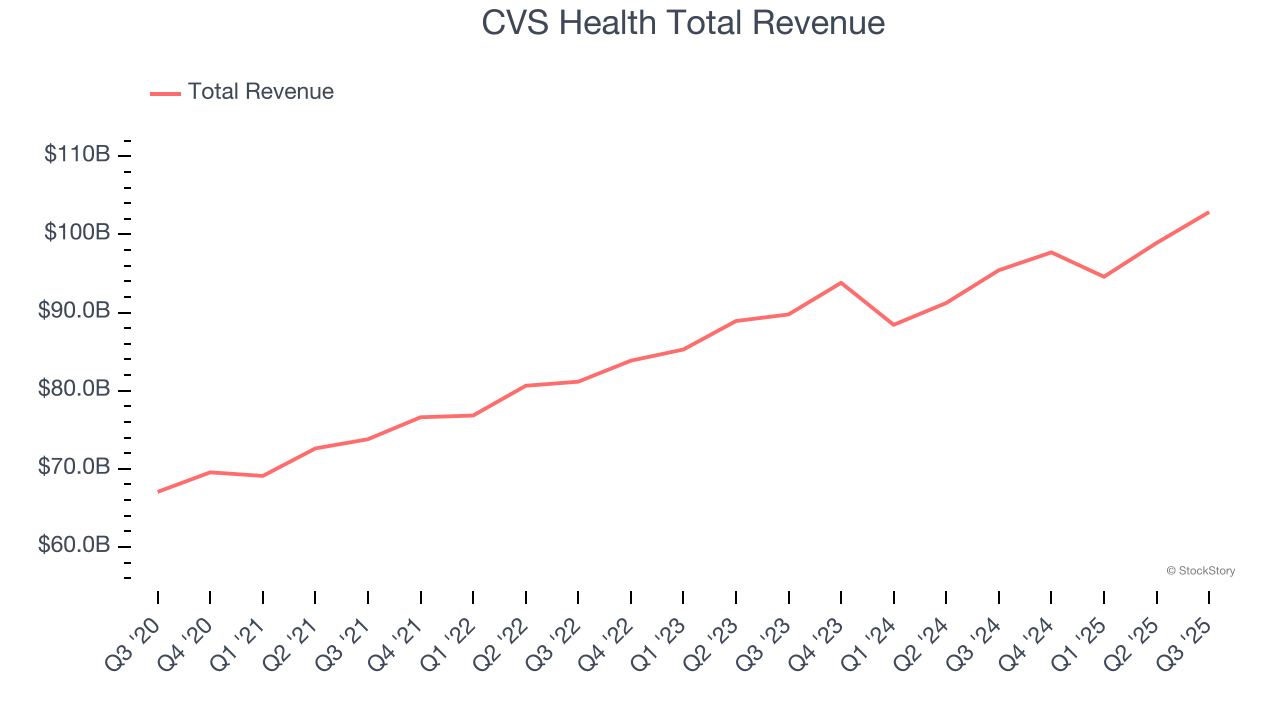
Wrapping up Q3 earnings, we look at the numbers and key takeaways for the health insurance providers stocks, including Centene (NYSE: CNC) and its peers.
Upfront premiums collected by health insurers lead to reliable revenue, but profitability ultimately depends on accurate risk assessments and the ability to control medical costs. Health insurers are also highly sensitive to regulatory changes and economic conditions such as unemployment. Going forward, the industry faces tailwinds from an aging population, increasing demand for personalized healthcare services, and advancements in data analytics to improve cost management. However, continued regulatory scrutiny on pricing practices, the potential for government-led reforms such as expanded public healthcare options, and inflation in medical costs could add volatility to margins. One big debate among investors is the long-term impact of AI and whether it will help underwriting, fraud detection, and claims processing or whether it may wade into ethical grey areas like reinforcing biases and widening disparities in medical care.
The 12 health insurance providers stocks we track reported a strong Q3. As a group, revenues beat analysts’ consensus estimates by 2.4% while next quarter’s revenue guidance was 2.7% below.
While some health insurance providers stocks have fared somewhat better than others, they have collectively declined. On average, share prices are down 4% since the latest earnings results.
Centene (NYSE: CNC)
Serving nearly 1 in 15 Americans through its government healthcare programs, Centene (NYSE: CNC) is a healthcare company that manages government-sponsored health insurance programs like Medicaid and Medicare for low-income and complex-needs populations.
Centene reported revenues of $49.69 billion, up 18.2% year on year. This print exceeded analysts’ expectations by 3.7%. Overall, it was an exceptional quarter for the company with a beat of analysts’ EPS estimates and an impressive beat of analysts’ full-year EPS guidance estimates.
"Our third quarter results and increased full year outlook demonstrate tangible progress against the near-term milestones we laid out for investors in July," said Chief Executive Officer of Centene, Sarah M. London.

Interestingly, the stock is up 13.5% since reporting and currently trades at $37.66.
Is now the time to buy Centene? Access our full analysis of the earnings results here, it’s free for active Edge members.
Best Q3: CVS Health (NYSE: CVS)
With over 9,000 retail pharmacy locations serving as neighborhood health destinations across America, CVS Health (NYSE: CVS) operates retail pharmacies, provides pharmacy benefit management services, and offers health insurance through its Aetna subsidiary.
CVS Health reported revenues of $102.9 billion, up 7.8% year on year, outperforming analysts’ expectations by 4.1%. The business had an exceptional quarter with an impressive beat of analysts’ same-store sales estimates and a solid beat of analysts’ revenue estimates.

Although it had a fine quarter compared its peers, the market seems unhappy with the results as the stock is down 3.9% since reporting. It currently trades at $78.98.
Is now the time to buy CVS Health? Access our full analysis of the earnings results here, it’s free for active Edge members.
Weakest Q3: Molina Healthcare (NYSE: MOH)
Founded in 1980 as a provider for underserved communities in Southern California, Molina Healthcare (NYSE: MOH) provides managed healthcare services primarily to low-income individuals through Medicaid, Medicare, and Marketplace insurance programs across 21 states.
Molina Healthcare reported revenues of $11.48 billion, up 11% year on year, exceeding analysts’ expectations by 4.7%. Still, it was a slower quarter as it posted a significant miss of analysts’ full-year EPS guidance estimates and a significant miss of analysts’ EPS guidance for next quarter estimates.
As expected, the stock is down 21.8% since the results and currently trades at $152.24.
Read our full analysis of Molina Healthcare’s results here.
UnitedHealth (NYSE: UNH)
With over 100 million people served across its various businesses and a workforce of more than 400,000, UnitedHealth Group (NYSE: UNH) operates a health insurance business and Optum, a healthcare services division that provides everything from pharmacy benefits to primary care.
UnitedHealth reported revenues of $113.2 billion, up 12.2% year on year. This number was in line with analysts’ expectations. Aside from that, it was a mixed quarter as it also logged a narrow beat of analysts’ customer base estimates but revenue in line with analysts’ estimates.
The company kept the number of customers flat at a total of 54.08 million. The stock is down 11.2% since reporting and currently trades at $325.20.
Read our full, actionable report on UnitedHealth here, it’s free for active Edge members.
Oscar Health (NYSE: OSCR)
Founded in 2012 to simplify the notoriously complex American healthcare system, Oscar Health (NYSE: OSCR) is a technology-focused health insurance company that offers individual and small group health plans through its cloud-native platform.
Oscar Health reported revenues of $2.99 billion, up 23.2% year on year. This result missed analysts’ expectations by 3.3%. Taking a step back, it was a mixed quarter as it also recorded full-year operating income guidance exceeding analysts’ expectations but a significant miss of analysts’ revenue estimates.
Oscar Health pulled off the highest full-year guidance raise but had the weakest performance against analyst estimates among its peers. The stock is up 5.3% since reporting and currently trades at $17.95.
Read our full, actionable report on Oscar Health here, it’s free for active Edge members.
Market Update
As a result of the Fed’s rate hikes in 2022 and 2023, inflation has come down from frothy levels post-pandemic. The general rise in the price of goods and services is trending towards the Fed’s 2% goal as of late, which is good news. The higher rates that fought inflation also didn't slow economic activity enough to catalyze a recession. So far, soft landing. This, combined with recent rate cuts (half a percent in September 2024 and a quarter percent in November 2024) have led to strong stock market performance in 2024. The icing on the cake for 2024 returns was Donald Trump’s victory in the U.S. Presidential Election in early November, sending major indices to all-time highs in the week following the election. Still, debates around the health of the economy and the impact of potential tariffs and corporate tax cuts remain, leaving much uncertainty around 2025.
Want to invest in winners with rock-solid fundamentals? Check out our 9 Best Market-Beating Stocks and add them to your watchlist. These companies are poised for growth regardless of the political or macroeconomic climate.
StockStory is growing and hiring equity analyst and marketing roles. Are you a 0 to 1 builder passionate about the markets and AI? See the open roles here.






